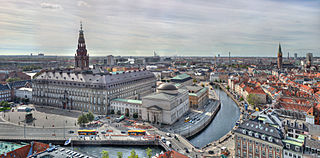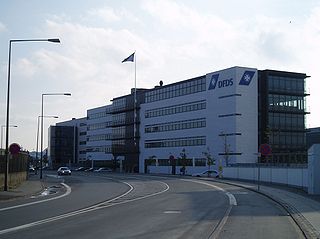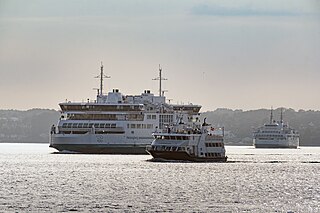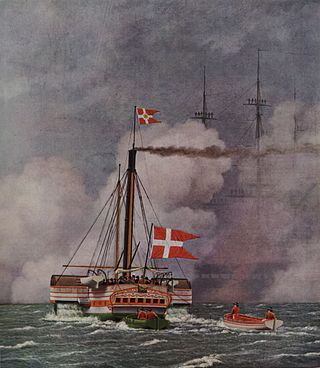Location

The company is headquartered at Snorresgade 18–20 in the Islands Brygge district of central Copenhagen. The building is the former home of International Harbester's Danish subsidiary.
| Company type | Private limited company |
|---|---|
| Industry | Shipping |
| Founded | 1969 |
| Founder | Arne Simonsen |
| Headquarters | , |
Key people | Arne Simonsen (CEO) |
| Revenue | DKK 6,7312 million (2012) [1] |
| DKK 90 million (2012) [1] | |
Number of employees | 2,410 (2013)) [1] |
| Website | scan-group.com |
Scan Group is a shipping and logistics company based in Copenhagen, Denmark.
The company was founded as Scan-Shipping by Arne Simonsen on 1 April 1969. [2] Scan-Shipping Airfreight was established in 1978. The first office outside Denmark opened 1973 in New York (since 1988 Shipco Transport Inc.). The name was changed to Scan Group in 2010. [3]

The company is headquartered at Snorresgade 18–20 in the Islands Brygge district of central Copenhagen. The building is the former home of International Harbester's Danish subsidiary.

Copenhagen is the capital and most populous city of Denmark, with a population of approximately 660,000 in the municipality and 1.4 million in the urban area. The city is situated on the islands of Zealand and Amager, separated from Malmö, Sweden, by the Øresund strait. The Øresund Bridge connects the two cities by rail and road.

Transport in Denmark is developed and modern. The motorway network covers 1,111 km while the railway network totals 2,667 km of operational track. The Great Belt Fixed Link connecting the islands of Zealand and Funen and the New Little Belt Bridge connecting Funen and Jutland greatly improved the traffic flow across the country on both motorways and rail. The two largest airports of Copenhagen and Billund provide a variety of domestic and international connections, while ferries provide services to the Faroe Islands, Greenland, Iceland, Germany, Sweden, and Norway, as well as domestic routes servicing most Danish islands.

DSB, an abbreviation of Danske Statsbaner, is the largest Danish train operating company, and the largest in Scandinavia. While DSB is responsible for passenger train operation on most of the Danish railways, goods transport and railway maintenance are outside its scope. DSB runs a commuter rail system, called the S-train, in the area around the Danish capital, Copenhagen, that connects the different areas and suburbs in the greater metropolitan area. Between 2010 and 2017, DSB operated trains in Sweden.

A.P. Møller – Mærsk A/S, also known simply as Maersk, is a Danish shipping and logistics company founded in 1904 by Arnold Peter Møller and his father Peter Mærsk Møller.

SAS AB, trading as SAS Group, is an airline holding company headquartered in the SAS Frösundavik Office Building in Solna Municipality, Sweden. It is the owner of the airlines Scandinavian Airlines and SAS Connect. SAS once owned 19.9% of the now defunct Spanish airline Spanair as well as shares in Estonian Air and Skyways Express. SAS Group is partially owned by the governments of Sweden and Denmark with a 14.82% and 14.24% holding, respectively. The remaining 70.92% is held by private shareholders, of which Foundation Asset Management owns 6.50%. The company is listed on the Oslo Stock Exchange, the Stockholm Stock Exchange, and the Copenhagen Stock Exchange.

DFDS is a Danish international shipping and logistics company. The company's name is an abbreviation of Det Forenede Dampskibs-Selskab. DFDS was founded in 1866, when C.F. Tietgen merged the three biggest Danish steamship companies of that day.

The rail transport system in Denmark consists of 2,633 km of railway lines, of which the Copenhagen S-train network, the main line Helsingør-Copenhagen-Padborg, and the Lunderskov-Esbjerg line are electrified. Most traffic is passenger trains, although there is considerable transit goods traffic between Sweden and Germany.

Lyngby station is a railway station serving the town and suburb of Kongens Lyngby in Greater Copenhagen, Denmark. It is situated centrally in Kongens Lyngby. With its large bus terminal, situated on the east side of the station, it is an important transport hub for public transport in the northern suburbs of Copenhagen.

The Danish National Archives is the national archive system of Denmark. Its primary purpose is to collect, preserve and archive historically valuable records from central authorities, such as ministries, agencies and national organisations and make them available to the public. The archive is part of the Ministry of Culture.
Events from the year 1876 in Denmark.

Næsseslottet is an 18th-century country house located on the shores of lake Furesøen at Holte north of Copenhagen, Denmark. The name, which translates as "Peninsula House", is a reference to the buildings setting on a narrow peninsula which extends from the east shore of the lake. The estate had previously been a royal farm known as Dronningegård and this name has long been associated with the locale.

Maersk Line is a Danish international container shipping company and the largest operating subsidiary of Maersk, a Danish business conglomerate. Founded in 1928, it is the world's second largest container shipping company by both fleet size and cargo capacity, offering regular services to 374 ports in 116 countries. In 2019, it employed 83,625 people where 18,398 of which are vessel crew and the other 65,227 are processing and operations personnel in offices and ports. Maersk Line operates over 708 vessels and has a total capacity of about 4.1 million TEU.

Danske Færger, styled as Færgen was a Danish ferry company. It was created on 1 October 2011 through the merger of Bornholmstrafikken and Scandlines' internal Danish activities. The company was a 50/50 partnership between the Danish state and Clipper Group. The company was first formed in April 2008 as Nordic Ferry Services. In 2018 Danske Færger was sold to Molslinjen.

Skodsborg Station is a regional railway station serving the suburb and seaside resort of Skodsborg, about 20 km north of central Copenhagen, Denmark.

Snekkersten station is a railway station serving the district of Snekkersten in the southern outskirts of the city of Helsingør, Denmark.

Helsingør station is the principal railway station serving the city of Helsingør in North Zealand, Denmark. It is located in the centre of the town, close to the Port of Helsingør, and immediately adjacent to the Helsingør ferry terminal and the Helsingør bus terminal.

Morten Helveg Petersen is a Danish politician who has been serving as a Member of the European Parliament (MEP) since 2014. He is a member of the Danish Social Liberal Party, which is affiliated to the Alliance of Liberals and Democrats for Europe Party, and sits in the Renew Europe group in the European Parliament. He was elected to the European Parliament in 2014 and 2019 and served as member of the Folketing 1998–2009.

The Helsingør–Helsingborg ferry route is a shipping route connecting Helsingør (Elsinore), Denmark and Helsingborg, Sweden across the northern, and narrowest part of the Øresund. Due to the short distance, which is less than 3 nautical miles, is it one of the world's busiest international car ferry routes, with around 70 daily departures from each harbour. The oldest-known written mention of the route dates to the German traveller Adam of Bremen in the 11th century, but it has likely been in use much longer. Before 1658, the route was a domestic Danish route. For several centuries, the route has been run regularly by various Danish shipping lines. Its significance grew during the 1950s, but since the inauguration of the Øresund Bridge in 2000, at the southern end of the Øresund, it has lost some significance but remains as one of the world's most important ferry routes, particularly as a cheaper alternative to the bridge tolls. Since 1952, passports have not been required for citizens of the Nordic Passport Union countries. Since 2001, when both countries became members of the Schengen Area, passports are not needed for anyone.

Eagle was a paddle-wheel steamer, built in England in 1821. The ship was bought by the Royal Danish Navy in 1824 and became its first steamship. It was bought as a personal transport for the Royal Family of Denmark and got the name Kiel. Rebuilt as a two-masted schooner in 1853 and eventually broken up in 1897.